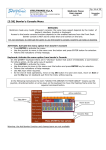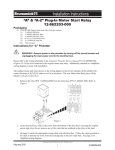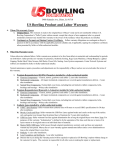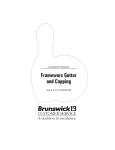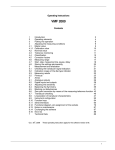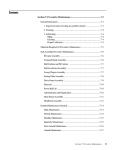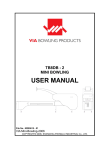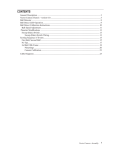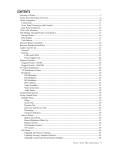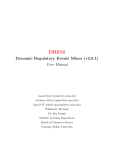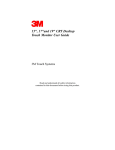Download Maintenance Manual - Steltronic Service Department
Transcript
Steltronic Focus Maintenance Manual Rev-b Steltronic S.p.A. Via Artigianale 34, 25082 Botticino Sera Brescia - Italy Tel: +39 030 2190811 fax: +39 030 2190798 http://www.steltronic.com Worldwide Service: + 39 030 2190830 Email: service@steltronic.com US Steltronic: +1 (909) 287-0712 service.usa@steltronic.com INDEX Checking the Sciba (Camera) photocell Checking the Sciba CCD Substituting the Sciba CCD Sciba CCD Mechanical calibration Front Desk Touch Screen Calibration Substituting a lane computer (VLC) Steltronic focus- Maintenance Manual –rev b Pg. Pg. Pg. Pg. Pg. Pg. 03 04 10 11 18 19 2 Checking the Sciba photocell The Sciba is equipped with 4 photocells (2 per lane) which are used to detect the passage of the ball for the ball speed calculation and for the pinsetter commands. The Photocells are usually mounted on the Sciba and in certain conditions directly on the Capping, the reflectors are mounted on the small capping on the opposite side of the lane. The pinsetter ball cushion micro switch is disconnected so that the pinsetter cycles when the scoring system gives the command. If the pinsetter does not cycle and the score does not advance, it is probable that the photocell has lost its alignment. BEFORE GOING TO CHECK THE PHOTOCELL ALIGNMENT CHECK THAT THE PINSETTER IS NOT BLOCKED FOR REASONS THAT ARE NOT CONNECTED TO THE SCORING SYSTEM (cams badly regulated, blocked motors, etc.) If your system does NOT use the Sciba CCD camera for reading pin fall, (GS10, Vollmer String, Vilati String, KF3000, Spellman string pinsetters) the only photocell is the one used for detecting the ball to calculate the ball speed (except the KF3000, Vilati and Spellman string). If the pinsetter does not cycle check the pinsetter sensors. ATTENTION! TURN THE PINSETTER POWER OFF BEFORE MAKING THIS CHECK. Take the Sciba CCD protection cover off. 1 = Electronic and optical Sciba CCD block. 2 = Photocells 3 = Signal board 4 = Support base There is a RED LED behind each photocell: if the Red light id on he photocell is lined up, if the Red Led is off the photocell is not lined up. In order to correctly align the photocell, loosen the 4 screws on top of the photocell support and move the photocell, aiming at the reflector on the other side of the lane until the red led comes on. When the Red Led comes on the photocell has been aligned. For a perfect alignment we advise you to cover the reflector with a piece of paper leaving only a small hole of about 2 cm in diameter in the centre of the reflector visible, in this way you are sure that the photocell is ‘looking’ at the centre of the reflector. Repeat the operation for all 4 photocells. If the Red Led goes off after the ball passes even after the photocell has been re-aligned then the photocell may be pointing towards the border of the reflector. Once the photocells have been checked (from a safe distance) test their functionality. Steltronic focus- Maintenance Manual –rev b 3 Checking the Sciba CCD By "checking the Sciba CCD" we mean, verify the direction the Sciba is pointing in respect to the position of the pins. This operation is carried out at the Main Desk computer, without any mechanical adjustments to the Sciba CCD itself. The Sciba CCD is a “Linear camera” which ‘reads’ the pins on a “ideal line” as can be seen on the above diagram. All 20 pins (2 lanes) can be seen on the ‘ideal line’. The ‘ideal line’ is at the neck of the pins which, seen from 4 meters, is the point that the pins are furthest from one another. IN ORDER TO OPTIMISE THE PIN COUNT BY THE SCIBA CCD WE ADVISE: • Change pins that are damaged or broken at the neck. • The neon lights on the lane pair must have the same brightness and intensity, any changes to lighting should be made per pair of lanes. • The Sciba is able to read (up to a certain point) even the ‘off spot’ pins, we suggest that the pinsetter positioning arms be checked on a regular basis. • Do not use pins which have black or coloured necks. Turn the pinsetters on that need to be checked. WAIT: the pinsetter pin deck light needs to warm up before giving the correct light. The pinsetters should be on first ball with ALL 10 pins standing on each lane. The Sciba CCD is able to see the red pins, we advise however to make the calibration settings with standard white pins. Switch the hall lights on just like when there are bowlers; sometimes neon’s placed too close to the pins change the light conditions and therefore the pin detection. Enter in the FOCUS program, than open the Pins Detection calibration or click on Camera icon in the lane manager menu. Steltronic focus- Maintenance Manual –rev b 4 1 3 4 6 5 [1] Camera Icon: clicking directly on the icon, will send the configuration to the camera. This button is used also for restart the communication with the camera, simply clicking on it. [2]ON-LINE Status indication: when the link with lane computer and Camera is Ok, the status is READY. If the Camera or the lane computer do not respond the status is FAILED. [3]Camera parameters: clicking directly on this line will open the CAMERA PARAMETERS window. In the Camera parameter window is possible change Brightness, Ratio, Frequency and Bank. [4] [5] Lane selection: clicking on the tag will change the lane view selection [6]GRAB IMAGE: clicking on GRAB IMAGE button will send a command to the camera for load in memory a pins photo shot. SUGGESTED OPERATIONS FOR FIRST CAMERA INSTALLATION (OR CAMERA SUBSTITUTION): • • • • Check the camera parameters Select a lane side and Grab Image Set Default position Save PINS position POST-INSTALLATION CAMERA CHECKING: • Check the camera parameters • Select a lane side and Grab Image • Save PINS position Steltronic focus- Maintenance Manual –rev b 5 CHECKING THE SCIBA (CAMERA) PARAMETERS Clicking directly on the blue line will open the CAMERA PARAMETERS window. Brightness: is the value given to the amount of light in the Sciba area. By lifting or lowering this value you let more or less light into the Sciba, just as if it where a standard camera diaphragm. a default settings is 4 (40 Ms). Ratio: is the light variation when the pin has been knocked down. In practical terms if the ratio is set to 50, the Sciba CCD will detect a pin as fallen when the light, in the area where the pin was when the first photo was taken, varies by at least 50%. This parameter need to be change only in EXTREME situation (pins dirty or light too dark), the default value is 50 Frequency: refers to the amount of ‘Hertz’ electricity. Set the value in accord to your local AC frequency: EUROPE = 50 HERTZ USA= 60 HERTZ CHINA=50 HERTZ Bank: the BANK is a conventional “point” for pre-set a brightness value. Bank 1 is used for saving the brightness value for white light. During ‘glow in the dark’ bowling the pinsetter neon is turned off, the only light is a ‘black’ florescent light. The Brightness set for the white light is not enough for the camera to see the pins correctly. It is necessary to increase the light that enters the camera by lifting the BRIGHTNESS value. In order to make the operation quicker, a second ‘Bank’ (2 or 4) is assigned to the Glow settings (with higher integration time). FIRST OPERATION: select the current ‘bank’ which is needed for this calibration: 1 or 3 for with light, 2 or 4 for glow bowling. Click on CHANGE BANK button to confirm. The screen will come back to main menu. SECOND OPERATION: once again click on blue line for opening the camera parameters window, vary (if necessary) the Brightness or other parameter, then click on SAVE PARAMETERS to confirm and exit. Steltronic focus- Maintenance Manual –rev b 6 GRAB THE IMAGE AND SAVE THE PINS POSITION First select one lane side, than clicking on GRAB IMAGE button will send a command to the camera for load in memory a pins photo shot. The Screen shot of the lane is load as a graphic. All the pins cursor are overlapped on right side of the screen. Click on SET DEFAULT POSITION BUTTON The pins cursor will be displayed on the approximate position. To Moving the pins cursor, click on the pin number button, keep the mouse button pressed, move to left or right the cursor, for finish the operation realise the mouse button. The pins are represented by the ‘peaks’ of different heights. The height depends on the distance from the neon light the pin is. Pins 1,3,2 and 5 are the highest ‘peaks’ as these pins are closet to the light, while pins 7,8,9 and 10 are further away and therefore receive less light resulting in lower ‘peaks’. As the example shows the 10 pin ‘peak’ height is 100, less than half of the height of the pin 1 ‘peak’ (250).This is okay but a ‘peak’ lower than 50 would not be detected. The yellow vertical window shows the searching area where Sciba looking for the pin. The windows must be in the centre of the base of the peak, it’s mandatory that all the near window’s do not overlap each other, otherwise the Sciba cant’ read the right pins. At the end of the operation click on SAVE PINS POSITION button, than wait till the Save pins position button became invisible, it’s means that the pins position is saved. REPEAT THE STEPS FOR THE OTHER LANE SIDE Steltronic focus- Maintenance Manual –rev b 7 CONFRONT IMAGES Note: this operation is required only for installation with One Sciba per one pair of lanes (STANDARD), for a odd lane installation confront image is not necessary. 1) Select ODD (or EVEN) lane, grab the image clicking on GRAB IMAGE button. 2) Select EVEN (or ODD) lane, grab the image clicking on GRAB IMAGE button. 3) Click on CONFRONT IMAGE button. The snapshot picture displays the graphic of both lane together. The height of the peaks must be similar: for example, pin 10 of odd lane, is approximately the same height of pin 10 of even lane. If the difference between the 2 lanes is too much, probably the camera is rotate clock-wise or anti clock-wise. SUGGESTIONS FOR A GOOD PINS READING It is important that the pins ‘peaks’ are a good distance from one another so that the pin detection is good. In cases where it is difficult to get good peaks, move the window slightly to allow more distance between them. If the Sciba CCD position is not correct or the ‘focus’ is out it can be regulated, the worst thing is the overlap of pin peaks, causing the Sciba CCD to detect one pin in place of another on the ‘ideal line’ and scoring it incorrectly. Brightness value is same for both lanes. Depending by pins illumination’s condition, even and odd lanes could display different peaks height, for same pins. It’s important to keep a Brightness media value in order to calibrate both lane as well. It is also possible, when the Brightness is too high, that the light saturates the lens and the peaks overlap (they tend to become one line at the top). If it is not possible to fix the problem by altering the Brighteners you need to MECHANICALLY CALIBRATE THE SCIBA; If this does not work, replace the Sciba CCD. The higher the peak is the more the peak tends to flatten. This phenomenon is known as IMAGE SATURATION when a pin peak is too saturated the Sciba CCD tends to ‘see’ the pin even when it has been knocked down. Set the light that enters into the Camera by changing the Brightness. If the pin ‘peaks’ are too high, being saturated with light, the Sciba CCD tends to ‘see’ them all the time, if the pin ‘peaks’ are too low the Sciba CCD has a hard time ‘seeing’ them. Integration time is the value given to the amount of light in the Sciba area. By lifting or lowering this value you let more or less light into the Sciba, just as if it where a standard camera diaphragm. Steltronic focus- Maintenance Manual –rev b 8 EXAMPLE OF WRONG CALIBRATION The peaks are too LOW; not enough light is entering the lens and the Sciba does not recognize the pins. Lift the Brightness The peaks are too high; too much light is entering the lens; the Sciba recognizes the pins ALL the time, even when they have been knocked down. Decrease the Brightness. The peaks are overlapped; the Sciba recognizes one pin in place of another, or worse it recognizes the pin in place of the one next to it. The Sciba may be out of focus. Lover the Brightness. IF THE OPERATION IS NOT SUCCESSFUL MAKE A MECHANICAL CALIBRATION. Steltronic focus- Maintenance Manual –rev b 9 Substituting the Sciba CCD The Sciba CCD is made up of two parts: The HEAD [1] that contains the electronics and lens. The BASE [2] which supports the photocells and the interface board. More often than not it is not necessary to change the entire Sciba CCD assembly, nor the entire Sciba head. If done carefully it is possible to change the electronic part only without doing a mechanical calibration. TO CHANGE THE SCIBA ELECTRONICS WITH LENS ATTENTION! Turn the power off to the lane computer or turn the I-Retro off (only if I-Retro with direct power model) Take the plastic cover off ( use a screwdriver to disconnect the 9 pole plug). Remove the aluminium lid by unscrewing the 4 lateral screws. Remove the 3 screws (A, B and C) that hold the lens ring. SLIGHTLY loosen ONE of the 2 fixing bolts (D or E). DO NOT LOOSEN THEM BOTH SO THAT YOU MAINTAIN THE CALIBRATION POSITION. Carefully remove the electronic boards from the back of the block, if necessary loosen one the bolts a little more. INSERT THE NEW BLOCK (lens + electronic boards), turn it until it positions itself against the bolt (D or E) which you did NOT loosen, then tighten the loose bolt firmly. Replace the lens ring and tighten the 3 screws tightly, without exaggerating replace the lid. Before calibrating the Sciba from the Main Desk computer click on the SET PREDEFINED button on the Sciba settings screen to load the original settings. Proceed with the calibration from the Main Desk computer. If, during the replacement, the Sciba has moved, return to the mechanical calibration. It is advisable, once checked that the position of the Sciba is correct, to use ordinary nail varnish to block the bolts and screws. Don’t use substances which ‘permanently’ fix the screws and bolts as this will make it impossible to service when required. Steltronic focus- Maintenance Manual –rev b 10 Sciba CCD Mechanical calibration This type of calibration is necessary if the Main Desk Computer calibration has failed because it’s not possible to find an ideal position for the vertical pin lines (sign that the Sciba has moved or needs to be replaced) BEFORE DOING THIS TYPE OF OPERATION ASK FOR ADVISE FROM YOUR SUPPLIER OR FROM YOUR AUTHORIZED SERVICE CENTRE Take the pins off the pin deck and position the calibration boards supplied during installation. Check if the pinsetter neon is switched ON and that the light conditions are the same as when there are bowlers. Obscure any lights that may effect the pins which are not usually present. Warning! Placing the template on the lane deck is dangerous with pinsetter motor on. Before to proceed, disconnect all pinsetter motor keep only the pinsetter pins light on Unplug the pinsetter motor connectors, than switch on the 2 pinsetters. Before to begin, please wait some minutes cause the pit light must be hot. The template should be placed symmetrically near the border of the pins spot as shown in the next diagrams. Position depends also by lane installed: • • Standard installation: one Sciba per one pair of lane ODD installation: one Sciba per each lane Standard Installation: one Sciba per one pair of lane Standard Template position Installation with ODD lane: Sciba mount at the right side of the lane Steltronic focus- Maintenance Manual –rev b 11 ODD Template position Installation with ODD lane: Sciba mount at the left side of the lane ODD Template position BEGIN THE MECHANICAL CALIBRATION With the Sciba in calibration mode, LED 10 starts flashing and the other LED’s indicate how the position should be adjusted, if adjustment is required. The machine is correctly adjusted when all four GREEN LED’s are lit. Activation of calibration mode for standard Sciba installation (one Sciba for one pair of lanes) Move the switch on Sciba board in CALIBRATE MODE(on top) Steltronic focus- Maintenance Manual –rev b 12 Activation of calibration mode for ODD Sciba installation (one Sciba for each lane) Set the Move the switch on Sciba number 1 board in CALIBRATE switch of S1 to MODE(on top) “ON” (Dip Switch) and leave it on BEGIN TO ADJUST MANUALLY THE SCIBA The scan line can be mechanically adjusted in three ways: 1) Rotation on its vertical axis 2) Rotation on the optical axis 3) Raising / lowering the scan line. First loosen (a little bit) all the mounting bolts. Adjustments should be carried out in the following order - first the vertical axis, then the optical axis and lastly the height. The Led’s indicate in which direction the Sciba should be adjusted. After each adjustment, tighten the relative adjustment bolt. Steltronic focus- Maintenance Manual –rev b 13 MECHANICAL CALIBRATION: ROTATION ON IT’S VERTICAL AXIS WARNING! MOVE THE SCIBA LITTLE BY LITTLE [ PUSH VERY GENTLY THE SCIBA BY ONE SIDE, WAIT THE RESPONSE FROM THE LED, THEN PROCEED AS NECESSARY]. OK! THE VERTICAL AXIS IS ADJUSTED CORRECTLY. LOCK THE NUT. If both LED 1 and LED 3 are lit, it means that the Sciba cannot identify the marker sheets: 1] Check the Sciba position (maybe the Sciba is placed at the wrong distance) 2] TRY TO CHANGE THE INTEGRATION TIME: the neon light (from pinsetter) is not enough or is too much for the Sciba; try to implement more integration time 1 by 1 or 2 by 2 and try to make the calibration. If the problem persist decrease the integration time. Steltronic focus- Maintenance Manual –rev b 14 MECHANICAL CALIBRATION: ROTATION ON THE OPTICAL AXIS Allen key type bolts, on the front of the Sciba (the three projecting bolts, not to be confused with the two, more flush bolts used to set the lens when it has been focused) must be loosened. After the adjustment close STRONGLY. OK! ROTATION ON OPTICAL AXIS CALIBRATE SUCCESSFULLY! CLOSE VERY TIGHT THE 3 BOLT. IF IS HARD ADJUST THE OPTICAL AXIS: Try to lose or thigh the BOLT as indicated in the diagram in left side, then adjust the Sciba. Steltronic focus- Maintenance Manual –rev b 15 MECHANICAL CALIBRATION : RAISING/ LOWERING ALL DONE! THE SCIBA IS NOW FULLY MECHANICALLY ADJUSTED. When the Sciba has been correctly adjusted, the above three green LED’s (central in each of the settings) remain on, the 10th LED stops flashing also remaining on. WARNING! Replace the calibration switch in OFF position, or the Detection Device does not works and gives message TIME OUT! On the console (in the scanning mode). Steltronic focus- Maintenance Manual –rev b 16 SUGGESTIONS ABOUT PINS POSITIONS Each of the pins must be fully visible by the Sciba (not partly hidden by other pins). The distance between the following pairs of pins is of vital importance: • pins 1 and 8 on the left lane • pins 4 and 7 on the left lane • pins 1 and 9 on the right lane • pins 6 and 10 on the right lane The distance between each pair may not be enough, and although moving the Sciba may improve the view, it may, in the same instant make the view of another two pins worse, so it is usually better to move the pins (slightly). E.g. Improving may alter and vice versa. As improving may alter the view of and vice versa. Some problems that may arise, with hard to see pins and how to solve them. and (vital) Move the Sciba closer to the two pins keeping to the center of the lane, until a point is reached where the situation improves. and (vital) Move the Sciba farther from the pins keeping to the center of the lanes. and (vital) If the lanes are not symmetrical, forcing the Sciba to be positioned ‘Off ’center, then in this case, move the Sciba to the right and if necessary, a little forward (towards the Pinsetter). and (vital) Move the Sciba to the left of the center line and if necessary, a little back(towards players table ). Irrespective of how the Pinsetter places the pins, the best position for the Sciba is on the line between the following two points: Point 1: Where a line passing through the centres of pins 7 and 4, on the left lane meets a line passing through the center of pins 6 and 10, on the right lane. Point 2: Where a line passing through the center of pins 1 and 8, on the left lane meets a line passing through the center of pins 1 and 9, on the right lane. If the segment between points 1 and 2 is traced, the ideal position for the Sciba is within the segment and is much closer to point 2 than point 1. The points can be calculated on paper using the pin grid, as actually drawing out the relative lines takes rather a long time! Steltronic focus- Maintenance Manual –rev b 17 Front Desk Touch Screen Calibration Calibrating the computer monitor touch screen in necessary when the cursor does not follow the commando given with the finger correctly. Calibrate the monitor after it has been moved as well. Attention! If the Touchscreen monitor was switched on AFTER the computer had already loaded Windows the TOUCH function is DISABLED. Restart Windows to reactivate the Touchscreen. The touchscreen models in use are ELOTOUCH or MICROTOUCH. Both of these models could be serial (connected to the computers COM 1) or USB. Before proceeding with the calibration, clean the screen with a slightly damp clean cloth, then set the screen to the adequate size. CALIBRATING A MONITOR WITH ELOTOUCH INSTALLED Click on the ELO TOUCHSCREEN icon found in the control panel of Windows (route: START→SETTINGS → CONTROL PANEL). Click on the CALIBRATE button to activate the menu. Touch the target, while standing directly in front of the monitor. Repeat the operation with all the targets the system presents. The next message asks you to touch the screen in various places to see if the cursor responds accurately. Click on YES to confirm or on NO to calibrate again. CALIBRATING MONITORS WITH MICROTOUCH INSTALLED Click on the MICROTOUCH TOUCHSCREEN icon found in the control panel of Windows (route: START→SETTINGS → CONTROL PANEL). Click on the CALIBRATE button to activate the menu. Touch the target, while standing directly in front of the monitor. Repeat the operation with all the targets the system presents. The next message asks you to touch the screen in various places to see if the cursor responds accurately. Click on DONE to confirm or on CALIBRATE AGAIN to repeat the operation. Steltronic focus- Maintenance Manual –rev b 18 Substitute a V.L.C (Vision Lane Computer) WARNING This operation interacts with focus database and therefore may cause problems if not carried out correctly. Read carefully the following instructions before you start, in case of doubt contact the Steltronic Service before action. Before you begin, check that the old lane computer is off. Close the Focus program the other workstations and not to resume the program until the end of the procedure. Each lane computer (V.L.C.) has an unique IP address written on a label close to the Network input; it’s mandatory enter the IP of the new lane computer before switch it on. When the new lane computer will enter in function, make the file sync operation to update with the same parameters of the previous. OPERATION FROM MAIN DESK (SERVER) ONLY (4) Select the OUTGOING lane computer (5) Type the NEW IP Pair lane number (2) Click on SHOW SERVICE MANAGER (6) confirm Use only in case of error: Cancel the changes and quit without saving (3) Cliccare here to insert the new VLC IP (1) Click here with the RIGHT mouse button. If the Lane Server icon is not visible, click on START All programs Steltronic Focus Service Manager Run the change of the IP, save the changes (Point 6), and confirm with OK. The Service Manager application exchange the IP address in the database and will be restarted automatically. At the end of this operation will be possible to connect and turn on the new lane computer and all the other focus workstations\lane computer. Steltronic focus- Maintenance Manual –rev b 19 FILE SYNC Sync files is an operation required to update the settings like advertisements, program version etc. on the new lane computer. The lane computer will not be available during the sync and will return in line automatically at the end of the operation that may require from 5-10 minutes, according to the speed of the network. Click here Click on SYNC files and confirm when the next question appear. WARNING! Do not turn off inadvertently the main desk (server), the network switch or avoid blocking inadvertently service Lane server. In case the not available Lane server, the lane computer will not update the files. In case of black out of the Centre during the operation, try again to run the sync, if the operation does not give a positive result, contact the Steltronic service . Steltronic focus- Maintenance Manual –rev b 20 10 11 13 12 11 10 9 8 5 9 8 5 7 7 4 4 6 3 1 2 6 3 1 VLC mod. A-B 2 VLC mod. C The VLC mod A and B are hardware compatibile, [1] AC selector (110/230VAC) [2] Main AC switch [3] AC Input [4] power ON led [5] ON/OFF/Stand by [6] AUX 12/5 VDC out [7] +12VDC out [8] COM1 (for A.P.I connection) [9] Lan input (network) [10] ODD monitor output [11] EVEN monitor output (DVI adapter mandatory) The IP label is near the LAN input Steltronic focus- Maintenance Manual –rev b 21 Steltronic Focus User Manual Maintenance rev_b March 2009 Steltronic S.p.A. Botticino Sera (BS) - ITALY Tel +39 030 2190811 Fax +39 030 2190798 http://www.steltronic.com info@steltronic.com Steltronic Worldwide Customer Service Botticino Sera (BS) - ITALY Tel +39 030 2190830 service@steltronic.com US Steltronic Customer Service Tel +1 (909) 287-0712 service.usa@steltronic.com Steltronic focus- Maintenance Manual –rev b 22






















